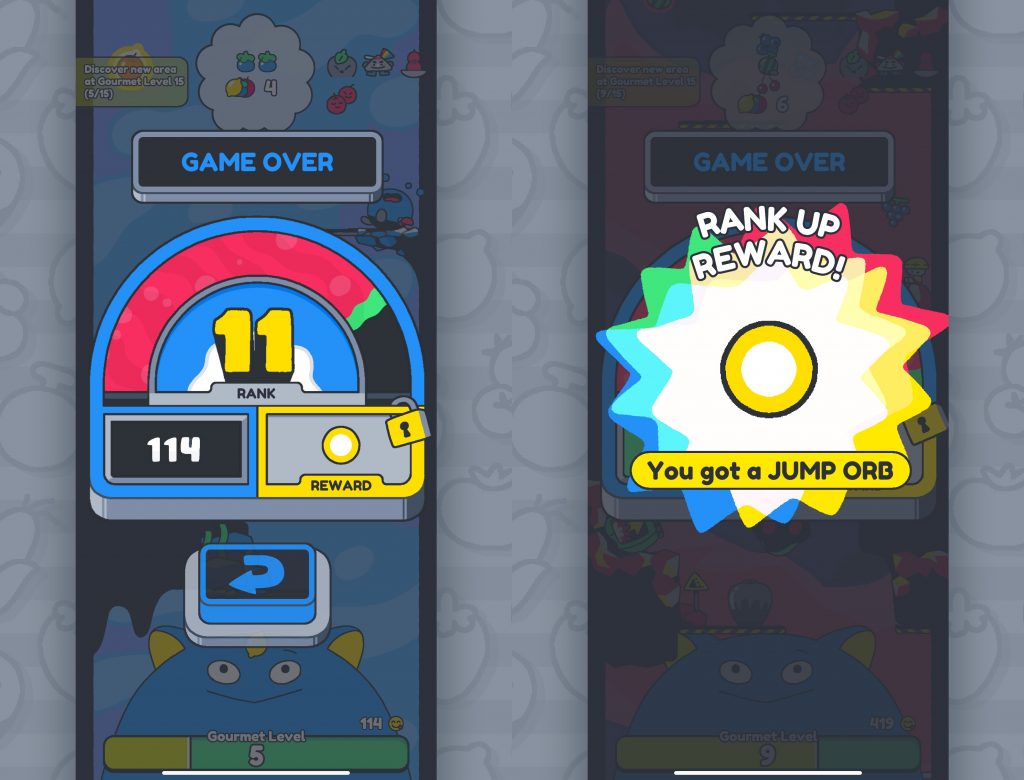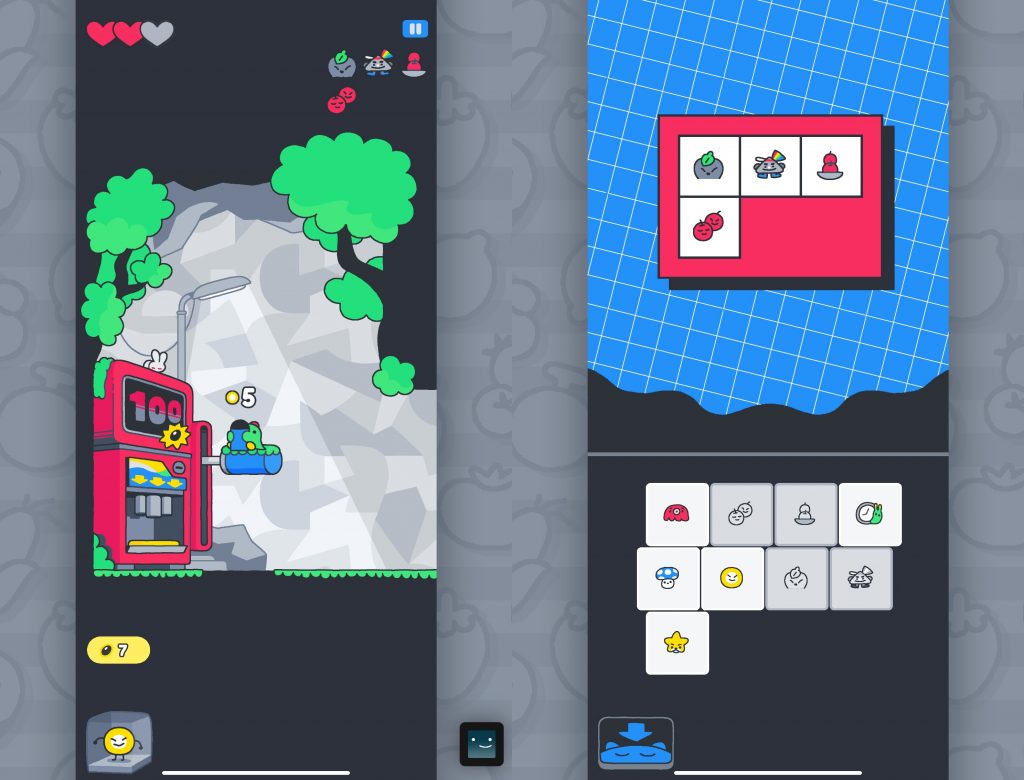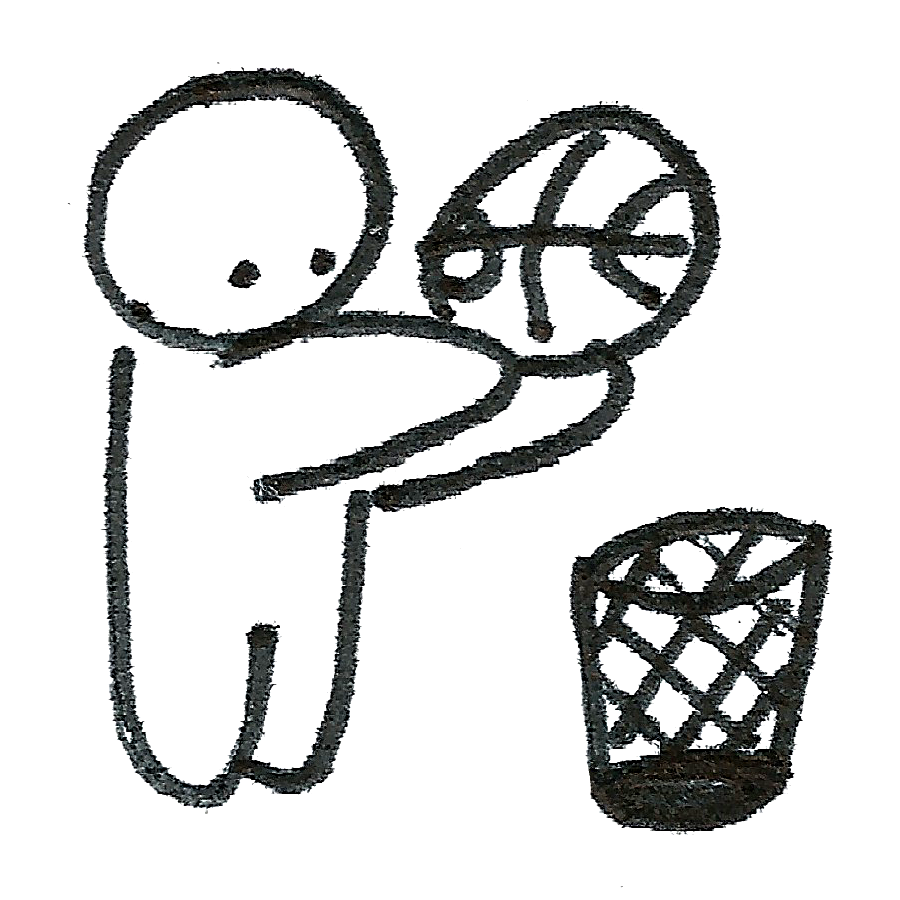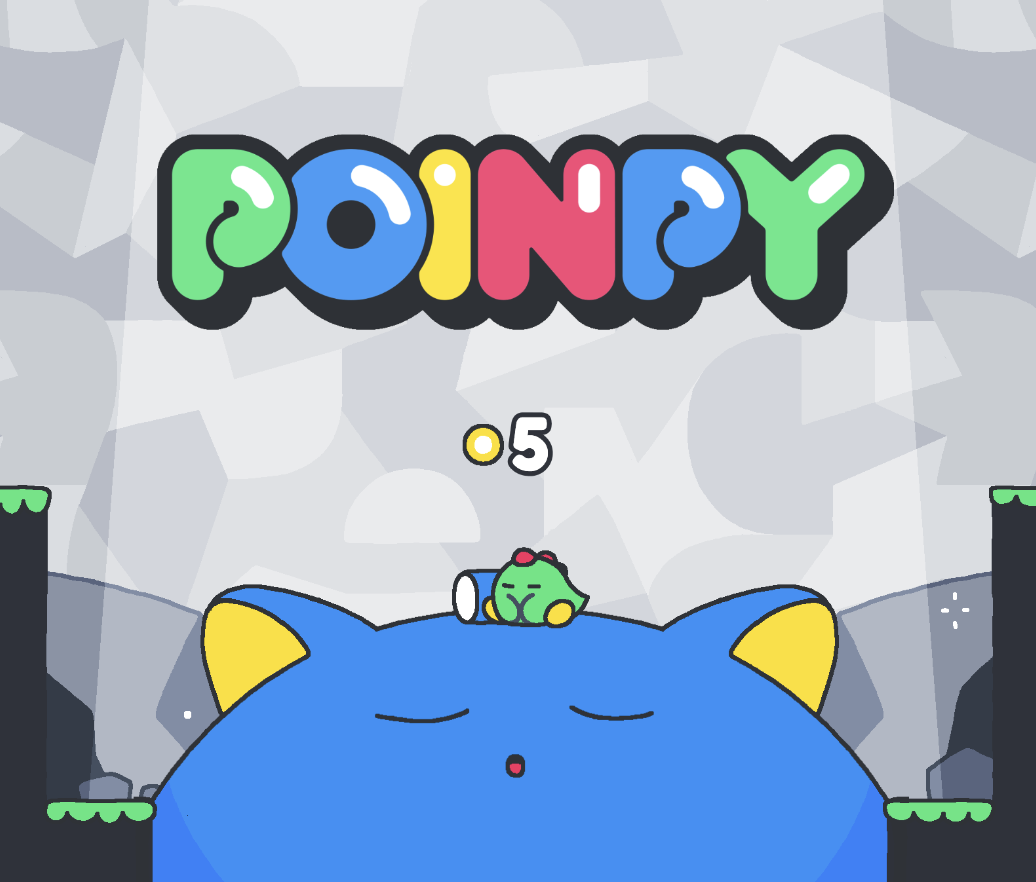[Let’s pretend this came out in December of 2022]
Poinpy is my 2022 Game Of The Year. As a mobile game available to anyone with a Netflix login, most people could be playing Poinpy within a minute, no matter where they are or what they are doing. Yet I’ve never talked to someone else who’s played Poinpy! No one has even heard of it! Maybe it’s because the name is too hard to pronounce, even though it is so much fun to say. Poinpy! Try it! ˈPoin(p)ē!
Poinpy is a platformer for your phone developed by Ojiro Fumoto with art by @2nd_Error403.* It’s Fumoto’s return to the indie scene after a brief stint at Nintendo where he worked on Ring Fit (Nintendo’s best new IP since Splatoon). Poinpy is a mirror image of Fumoto’s first hit, Downwell. In Downwell you descend down a well, and in Poinpy you climb up one. In Downwell you seek ground, and in Poinpy you avoid it as much as you can. In both, your key actions reload when you land. And while both Downwell and Poinpy’s procedurally generated tunnels give the appearance of infinitely scrolling arcade games, they both have definite endings.
In Poinpy you play as a cute dinosaur with a fruit blending bucket. A hungry beast demands smoothies, and it will incinerate you if you touch the ground without the specific ingredients. So you must ascend a well using careful wall bounces to collect the fruits. Additionally, you gain a jump whenever you land on an enemy or a pot, allowing you to chain together jumps and perform dazzling mid-air acrobatics to collect the floating fruit. As you feed the beast its demands grow more complicated, but the better you play the more permanent upgrades you unlock. This gives it a wonderful arc; in the beginning Poinpy is a puzzle-like challenge to carefully use your slim abilities to collect all the ingredients, but before long your familiarity and tools let you play it as an action game where you blast through enemies instinctively.
Of all the games I have played this year, Poinpy holds the highest esteem from me because it achieves the pinnacle of a genre on its platform without any superfluous waste detracting from its achievement. Poinpy presents players with a challenge that is interesting and that evolves over its runtime. It overflows with comfortable cuteness in its art, music, and game feel. All of this combines to make an experience that is deeply satisfying, and which I will remember fondly into the new year and beyond.
The platformer genre originated in arcades with Donkey Kong and Mario Bros, but flourished on home consoles during that period in the 80s and 90s when the sensibilities of the arcade experience still carried over to the living room. Arcade games have simple controls, short play sessions, and demanding difficulty. In the same way the first television shows were just people reading radio dramas, the first home console games carried these arcade traits. In time, developers would recognize that home consoles had their own set of virtues: longer play sessions, bespoke set pieces, and complex, standardized controls. But that shift would come after the platformer genre found its home. So while our sensibilities have changed as long as platformers are about slipping and falling the arcade will be in its blood. The arcade would return, however, in a new device that quickly gained ubiquity.
Mobile phones are the new arcade. A physical room of loud strangers has traded with a virtual one. Notifications from dozens of chat apps claw for your attention. You don’t wait in line to play, but you do play while in line. As a result, games with brief bursts of play thrive on the platform. A phone’s limited interface means that controls must be kept as simple as possible. These make mobile games resemble arcade games so closely that Apple even named their subscription service “Apple Arcade.” However, mobile phones have an important feature that arcades did not: the singular player profile. An arcade machine is shared by many players, but a phone has one owner. This allows for phone games to have persistent progression just like a home console.
The reason platformer games thrived on early home consoles more than in arcades was because consoles let you advance through a globe-trotting adventure bit-by-bit. The first Donkey Kong cabinet had only four levels, but on a home console Super Mario Bros. could have 32 levels. It wasn’t technical freedom that allowed for this, but a different reason: the game no longer needed to be shared among a crowd. Save systems soon allowed even more levels to be strung together. This made every victory in a play session another step along a grand journey. The lingering arcade sensibilities of precision and difficulty created engaging challenges, while the affordances of home consoles provided an arc that makes those challenges rewarding. Relatively speaking it was only a short blip of time when home console games had this overlap of styles that birthed the platformer genre. With mobile phones sharing that same mixture of both arcade brevity and console persistence, it seems like platformer titles should have seen a renaissance there; however, that has not been the case.
Platformers have languished on mobile phones because they lack the one trait that is most important to the genre: precision. Touchscreens struggle to offer tight controls. Buttons let you know their properties physically: the resistance of the spring, the click of the confirmation, and the shape of the button itself. All of these elements communicate the state of input, and let you control a character with 0.0167th a second of accuracy. Your finger can slide across a touchscreen frictionlessly, but that input is floaty and imprecise without any bounds. This is trouble for platformers because they are fundamentally games about intuitive physics. We understand how gravity works, so platformers ask us to react quickly and precisely to navigate up and around obstacles. The more precise that navigation can be the more possibilities there are for fun and varied challenges.
Consequently, the platform games that have found success on phones reduce their physics from two dimensions down to one. Temple Run, Flappy Bird, Mario Run, and Canabalt all push you forward automatically. You are not controlling left and right and up and down, just one or the other, usually with just a tap or swipe. This is not a dig at those games – they maximize a single input with enviable depth – but all of them have controls that are even more minimal than the arcade games that they are based on. Games that go in the opposite direction and try to emulate buttons on the touchscreen always suffer from input mistakes, like moving left when you meant to go right or missing the jump button. Even the platformer games that have exceptionally good virtual buttons, like the classic Sonic ports or Fumoto’s own Downwell, still suffer from the momentary second guessing that each input brings. Without clearly defined ridges around the buttons I always ask myself “Are my fingers in the right place?” before taking an action.
Here is Poinpy’s first step above its predecessors. Unlike Downwell, Poinpy’s controls are native to the touchscreen format and are elegantly designed to be played with a single hand (or finger!). Jumping is handled through a slingshot style drag that will be familiar to anyone who has played Angry Birds or Desert Golf. Press and hold down anywhere on the screen, pull back to set the jump direction, and then release to launch. The cross-cultural success of Angry Birds showed how intuitive this input is. You can start the drag anywhere, which keeps your eyes on the game and away from your thumbs. The fling can go in 360 degrees, allowing you to take full advantage of the 2D space. Poinpy enters slow-motion while you aim, which gives you enough time to be precise within that wide possibility space while maintaining a delicious time pressure. You can tell exactly where your character will launch before you commit to it thanks to a projected trajectory, but it will only show some of the route. The rest has to be imagined, and that is where the depth comes in.
One of the pleasures of the platformer genre is that with practice, your jump trajectory becomes internalized. Poinpy offers the same pleasure in the distance beyond the projected path. Because you want to stay in the air as long as possible, the further you can bounce your character around with each jump the better you will score. The fling is finely tuned between what it shows and what it does not, and how quickly you can act. Your score suffers if you stay within the handicaps of the projected path and the slow motion. These niceties make it easy to play competently, but Poinpy always pushes you to play better through complex motions and faster actions. Learn the physics to bounce off more enemies and walls with each jump, and turn those calculations into second nature so you can release your fling before wasting a millimeter of falling.
There is one other action Poinpy has – the ground slam. Tap on the screen and the character will pause for a tiny fraction of a second before slamming straight down. If you slam onto a pot or an enemy you’ll bounce back up to just below where you started the slam. This action is easy to do, but you have to remember what is directly below you to avoid breaking your jump combo. This includes remembering things that are off-screen, which are the most rewarding things to slam onto because it bounces you back to your original height as well as awarding you an additional jump. The speed of the slam contrasts with the arc of the fling, which rises and falls with gravity. The fling is full of grace, strategy, and anticipation, while the slam is punchy and determined. The contrast creates incredible pacing. Whiiiip foooooo BLAM bwoooing fwoop pwaaaaaang BLAM!
As you grow in proficiency with the flings and slams the targets you aim for increase in complexity. First they are stationary, then they are moving from left to right, then moving in mid-air, hopping in an arc, and so on. This evolution emerges naturally, as do all the other elements of the game’s various progression systems.

The overall goal in Poinpy is to feed the monster enough smoothies to unlock new areas. The more fruit in a smoothie the more points it doles, and once you have enough points then the level transitions into a new setting. Poinpy is run based; whenever you die you restart from the beginning with the score at zero. If you manage to unlock an area, though, it enters into the random rotation of areas on subsequent runs. Each area challenges specific play styles; the water level is about timing jumps, the fire level is about introducing a fireball state, and the palace is about using wall bouncing to get around overhangs. When a new area is unlocked, a set of puzzle challenges unlock as well. These puzzles use hand crafted scenarios to teach advanced techniques and are elegantly stashed to the side of the title screen, where you return after each run. The room is empty to begin with, but as you level up you gain the ability to climb the empty room to reach a secret throne hidden above and out of sight. This setup masterfully makes you feel smart for discovering it without actually being hidden at all. It makes you say “Ah-ha!” and then it rewards with more opportunities to feel clever in the puzzles themselves.
Reaching a new area is exciting and motivating, but the primary gameplay evolution occurs through a pair of parallel progression systems: the player level and ‘seeds,’ the in-game currency. After each run, your smoothie score is pumped through a leveling meter. When you reach a new level, you unlock either a permanent upgrade to your number of jumps or equipment slots, or a big bag of seeds. The additional jumps allow you to travel through the air for longer without hitting the ground, making it easier to collect fruits and reach higher scores. The equipment slot allows you to apply a modifier that changes your character or the level. These modifiers are purchased using seeds. A cheeky gachapon machine dispenses three random modifiers, of which you can only keep one. This provides the thrill of randomness without the dissatisfaction of a bad roll. You don’t know what you will get, or even what is possible, but you get to keep your favorite! This leveling system is another part of Poinpy that is mobile native: recognizing the best pleasure of gacha without the predatory aspects.

These modifiers provide the greatest source of evolution over Poinpy’s playthrough. Because they are unlocked semi-randomly they push you to explore different playstyles. Eventually you have the experience and tools to define your personalized kit. Good at slams? Increase the number of pots! Narrowly missing fruit? Have them suck in at the start of a slam! Many modifiers synergize with others, and figuring out the combos is a rewarding puzzle that feels like sneaky cheating. By the end of the game I had constructed an invincible dinosaur that blasted through areas like superman. Working up to it, each run felt like a step forward thanks to the leveling meter. The steady stream of new modifiers provided novelty around each corner, and clicking them together gave me a sense of clever ownership over the game. This novelty may have worn out, though, if the game didn’t have an ending to work towards.
Poinpy can be played infinitely, but if it was only an infinite game then it would have lost my interest. Unlocking new things only feels satisfying if those new things are pushing you towards something tangible. Progress needs a destination, and without spoiling it, Poinpy delivers with a final area to reach and surpass. Games without end states inevitably leave a taste of guilt, no matter how good they are. Any Animal Crossing player knows this bitterness well – our time with the game can be full of happy, worthwhile memories, but once you move on with your life to something new it feels bad to leave a game world ‘undone.’ This happens even for multiplayer games, like this year’s fantastic Splatoon 3. I can say a million good things about that game, but when I think about Splatoon 3 I would be lying if I didn’t mention the guilt I feel for not playing it literally right now. I know in my gut I didn’t finish my time with Splatoon 3, but no one ever can. I have no such reservation with Poinpy. I may have had more fun in moments playing Splatoon 3 than I have with any other game this year, but when I reflect on the totality of a game’s experience Poinpy’s ending lets me sit then and forever in perfect satisfaction.
Except, Poinpy’s ending plays a subtle trick. I began to sense it as I approached the final area. I had slipped and died just short of my ultimate goal, and as I watched the leveling meter fill up with my spoils and tick to level 18, I felt a sense of dread. I unlocked the last equipment slot, and realized I could have reached the ending before hitting this level. I didn’t need the equipment slot. I could have beaten the game earlier, without all the powers that were bending the game in my favor. I didn’t need them, I was a better player now. But you can’t unwind a level. That number only goes up. Whatever level I am when I beat the game, that will be how good I am. I couldn’t unrealize the fantastic and horrible truth. I don’t want that number high, I want it low. Poinpy isn’t basketball. It’s golf.
I knew with certainty then that after the credits rolled Poinpy would show me my level. It would say nothing about it. Poinpy would make no judgment. No suggestion. It would never have to. Like the hidden puzzle room or the modifier combos, it trusted me to make my own discovery and push myself to take a new challenge. We hate someone telling us we could do better, but it’s beautiful to say to ourselves “I know I can do better.” I’ve beaten Poinpy now, after slipping and falling and hitting the level cap. It was thrilling – when I started the game each failure felt like a gentle step forward, but when I was finishing it I could see each failure stacked side by side on that level bar. The drama amplified. When I finished, I knew I could have done so much better. I was ready to restart the game as soon as I finished it. Poinpy is a game that can be played infinitely, but it has a definite ending. That definite ending, as the deft combination of all its systems, produces the best of all feelings: total satisfaction for what I have done, and welcome arms to come back and try again. The rewarding journey of a home console experience, and the daring depth of the arcade.
That rewarding journey exemplifies the home console experience, and that daring promise of a worthwhile return epitomizes the arcade style. With this ending Poinpy succeeds in taking the platformer back to its roots in the overlap between arcades and home consoles. Reflecting on the games I played this year, I could have called out the ones that gave me the greatest instants of excitement or the ones that pushed and experimented the most, but in my opinion Game of the Year is for the whole game. I didn’t have the space to touch on the art, music, or haptics of Poinpy, but everything is harmonious with the core mission of crafting a comfortable and satisfying experience. Through the controls and progression systems it represents a maturation of Fumoto’s style of design, and exemplifies the genre on its platform like nothing else. I feel very glad to have played it, and I hope it continues to get the recognition it deserves!
Footnotes:
*Poinpy is so neglected online that there isn’t even any record of the game’s credits anywhere. I had to open the game to double check that I wrote artist @2nd_Error403’s name correctly!
Special thanks to Milena Correa and Kevin Wong for their input in editing this piece!
If you have enjoyed reading this, consider signing up for the Saving Game newsletter! I will always post these on my website, but with the newsletter all future essays can go straight to your inbox, sometimes with extra goodies.

